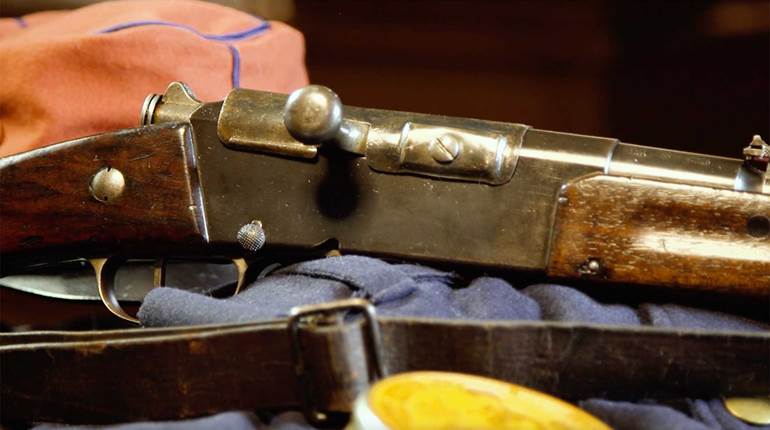
The first smokeless powder rifle was the famous French Lebel 1886, which used a revolutionary new type of propellant, the nitrocellulose “Poudre B,” and nearly doubled the velocity and power of rifle bullets. Overnight, every other rifle design that still used the old dirty blackpowder became instantly obsolete, and there was a scramble by all the powers of Europe (and reluctantly by the United States as well) to adopt their own smokeless powder rifles and cartridges to avoid being left behind.
While this is true, and the Lebel was the first military rifle with smokeless powder ammunition adopted formally for the entire army, the existence of other potential propellant powders was known before 1886. The crudest form of nitrocellulose powder (which we call “single base powder” today) is guncotton. It was discovered in the mid-1840s by Schoenbein, a Swiss-German chemist, and before the end of the decade, most European major military powers had conducted experiments on the potential of guncotton as a replacement for gunpowder.
Professor Schoenbein named his discovery “Schiessbaumwolle,” or literally, “shooting cotton.” From nearly the moment of its discovery, the stuff was proposed as a more powerful gun propellant. Ordinary cotton was prepared in a mixture of nitric acid and sulfuric acid before being carefully washed, and this produced a composition that was several times more powerful than blackpowder.
Unfortunately, nitrocellulose is so powerful, and its explosive action so fast, that it shattered ordinary musket barrels. All the military powers abandoned their experiments in the late 1840s or the early 1850s, after finding no way to tame the uncontainable power of guncotton. All that powers, that is, except for the Austrian Empire. General Wilhelm Lenk von Wolfsberg was an Austrian artillery officer, and he convinced Emperor Franz Josef to continue the guncotton experiments. If von Lenk was successful, he could deliver to the Imperial and Royal Army a powerful new gun propellant that offered numerous advantages.

Guncotton makes virtually no smoke when it is fired and doesn’t leave residue behind in the gun barrel. Blackpowder, meanwhile, creates clouds of stinky smoke and leaves fouling that accumulates in the barrel. After several years of experiments, von Lenk discovered that the rapid burning of guncotton could be slowed down by weaving it into longer strips and making very long cartridges for small arms and artillery. If compressed in a gun chamber like ordinary blackpowder, guncotton would shatter the barrel, but when formed into a long cartridge that was not compressed, the guncotton burned slow enough that it could propel a bullet but not burst the gun. Von Lenk was convinced he had unlocked the secret, and there was lots of excitement in Austria in the late 1850s and early 1860s.
New models of artillery pieces were designed specifically to use the powerful new guncotton, and by 1862, the Austrian Army had fielded 30 batteries of the experimental “Lenk’sche artillerie” into tentative service. There were still some issues to be resolved, but von Lenk had achieved his goal of developing guns and ammunition that could safely employ his guncotton. With artillery being fielded, and a full widespread adoption of the new “Schiesswollkanonen” anticipated, von Lenk turned his attention to small arms.
In 1861, the service rifle for the Austrian Army was the Model 1854 Lorenz in .54 caliber, a conventional percussion muzzleloading rifle musket. Von Lenk’s cartridge for the Lorenz was unlike any other cartridge in use, and still looks utterly bizarre even today! The cartridge used the standard Austrian compression bullet, but a 3”-long wood stick protruded from the base of the bullet, and the guncotton propellant was placed around the stick. This was necessary because the stick prevented any compression of the guncotton in the chamber of the Lorenz rifle; if compressed even a little bit, the gun might blow up. The stick physically ensured enough space remained in the chamber, but just to be certain, von Lenk’s final version of the Lorenz cartridge was loaded simply by dropping it down the barrel, without the ramrod. The guncotton burned cleanly and left no fouling behind, so shots could be rapidly and easily reloaded. Lorenz rifles intended for using von Lenk’s cartridge had a recess machined into the breech-face, and the stick would lodge in this recess, holding it firmly and preventing the cartridge from sliding back out of the barrel if the muzzle was tipped down. And to prevent accidental double-loading (firing a double loaded guncotton cartridge would blow the barrel to shards), a cardboard wad was lightly held atop the nose of the bullet; when the cartridge was loaded, the wad would remain stuck at the very end of the muzzle, indicating the rifle was loaded.

Soon the guncotton Lorenz cartridges went into production at the Imperial-Royal guncotton factory, and they were issued to the troops for large scale tests. Some were even issued to Austrian troops on campaign in the Schleswig War of 1864, although they were not to be used in combat; the rounds were carried by the troops for several months, and then tested for deterioration. They were found to be undamaged by months of marching and field service and shot just as well as new cartridges. In speed firing tests, a soldier fired 55 rounds in 9 minutes and 30 seconds, a rate of fire of over six rounds per minute.
By the start of 1862, there was a growing expectation that guncotton propellant would replace blackpowder for both the Austrian infantry and artillery. Although the guncotton experiments were a state secret, word was getting out to other countries (including even to the United States!), and foreign powers started to pay attention. Maybe they had been too quick to give up on guncotton? From 1851 to 1862, the Austrians had been experimenting with guncotton in increasing quantities, without a single accident. The Austrian military press was almost giddy with excitement. In a future war, Austria’s enemies would be stuck with blackpowder, while Austrian troops would be able to fire rapidly without producing any smoke. Best of all, the guncotton increased the muzzle velocity of the bullets, which gave a profound advantage over the much slower bullet propelled by blackpowder from a rifle musket.

Then on July 30, 1862, a magazine full of guncotton exploded just outside of Vienna. An investigation concluded that the devastating explosion had been caused by the spontaneous ignition of guncotton. Further research determined that guncotton was unstable if the tiniest amount of acid from the production process remained on it. Over time, the acid would cause decomposition, creating heat, and then potentially a sudden spontaneous eruption of flames. Von Lenk took the Vienna magazine explosion in stride and pointed out the numerous blackpowder mills that had exploded between 1851 and 1862. His guncotton was even safer than blackpowder, he argued … but the possibility, however remote, that guncotton might just randomly burst into flames at any moment was too much for the Habsburg military authorities. The traditional ruling elites in the old Austrian Empire had been suspicious of guncotton from the start, and the Vienna explosion was all they needed to convince the emperor to abandon the experiments. Kaiser Franz did order the disbandment of von Lenk’s batteries of guncotton artillery, but he allowed the continued production of guncotton and experiments to continue, in hope perhaps of some future breakthrough.
It was not to be. In 1865, there was another explosion, many times worse than the 1862 blast, which destroyed a large guncotton facility. That was the last straw. A year before the Austro-Prussian War, the Austrian Empire abandoned all further research and production of guncotton firearms. The Austrians also doubled down on French-style shock tactics, which emphasized bayonet assaults over firepower. When Austria and Prussia went to war in 1866 to decide the future of central European hegemony, the Austrian infantry suffered terrible casualties when they charged madly towards the Prussians armed with the breechloading Dreyse needle-rifle. Prussia won the battle, and Germany was unified around Berlin instead of Vienna. Yet it is still interesting to imagine, what would have happened if von Lenk prevailed and Austrian troops in 1866 were armed with guncotton?
About 25 years later, a French chemist discovered a way to safely slow down the energy release of nitrocellulose through a chemical treatment process, which also made it stable for long periods. And so, it would be the French with the Model 1886 Lebel rifle who first introduced smokeless powder, instead of the Austrians in 1862. But it is interesting to sit back and imagine… what if the Austrians had guncotton firearms in 1866?






































